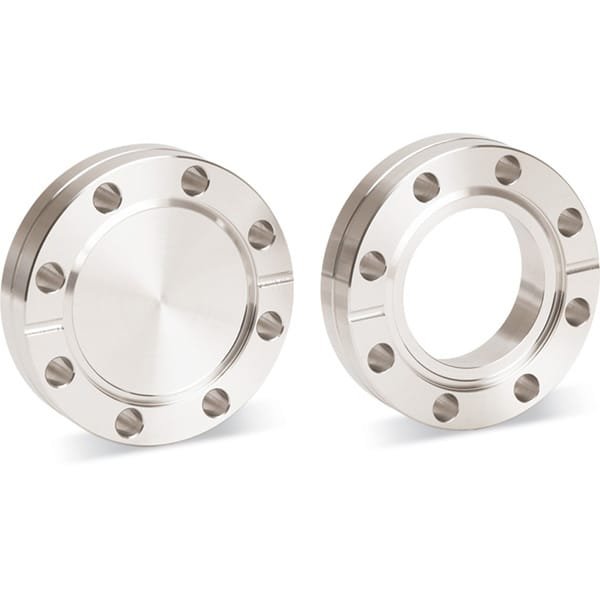Overview of ConFlat Flanges for High Vacuum and UHV Applications
ConFlat (CF) flanges are highly favored for high vacuum (HV) and ultra-high vacuum (UHV) systems due to their reliability and versatility. These flanges support a wide range of vacuum components, including gauges, instruments, feedthroughs, and accessories, making them integral to complex vacuum systems.
Blank (Blind) Flanges
A blank, or blind, flange is a solid, disc-shaped fitting designed to close off unused ports or sections in a vacuum chamber. They can also be machined to create custom fittings or adapted for various configurations within vacuum systems.
CF Flange Sealing Mechanism
The sealing mechanism of CF flanges is based on a knife-edge structure machined just below the flange’s flat surface. When a pair of flanges is bolted together, these knife-edges press into a soft metal gasket, forming grooves that compress the gasket material. This process fills surface defects, creating a reliable, leak-tight seal. CF seals can withstand pressures ranging from 760 torr (103 mbar) to ultra-high vacuum levels as low as <1 x 10⁻¹³ torr (<1.3 x 10⁻¹³ mbar) and operate effectively across temperatures from -196°C to 450°C, depending on the material.
Size Nomenclature
In North America, CF flanges are typically referenced by their outside diameter (O.D.), while in Europe and much of Asia, the nomenclature is based on the nominal internal diameter (I.D.) of the largest tube that can be welded to a bored flange.
Types of ConFlat Flanges
CF flanges are available in two primary configurations:
- Fixed Flanges: These flanges are a one-piece design where the bolt-hole orientation is set relative to the fitting. Fixed blank flanges are commonly used to seal off ports that are not in use, providing a leak-tight assembly. Fixed bored flanges, on the other hand, are designed to accept standard tube sizes and can be welded onto components.
- Rotatable Flanges: Rotatable flanges consist of two parts—an inner weld ring and an outer bolt ring. This design allows the bolt ring to rotate freely around the inner ring, facilitating easy alignment with mating flanges. Rotatable bored flanges are ideal for systems where bolt-hole alignment is crucial, as they can accept standard tube sizes and be welded onto various components.
Both fixed and rotatable versions can be ordered with clearance-holes or tapped holes.
Hole Types
- Clearance-Holes: These are through-holes that provide sufficient clearance for bolts to pass through both flanges, secured by nuts or plate nuts.
- Tapped Holes: These holes are machined with imperial or metric threads, allowing the flange to be fastened without the need for nuts or plate nuts. It is essential to consider bolt-hole orientation when selecting tapped flanges to ensure proper alignment with system components.
316LN Stainless Steel: Key Features
For enhanced performance, CF flanges made from 316LN stainless steel offer several benefits:
- Increased Hardness: With a hardness rating of 170 on the Brinell scale, 316LN is more durable than 304L stainless steel, making it ideal for applications that involve frequent disassembly and reassembly.
- Electro-Slag Remelting (ESR): This process improves the homogeneity of the metal, reducing the presence of macro segregation and enhancing overall material quality.
- Low Magnetic Permeability: 316LN stainless steel has a magnetic permeability (µ) of ≤1.005, significantly lower than that of 304L (µ = 1.03), making it better suited for applications sensitive to magnetic interference.
These features make ConFlat flanges a critical component in ensuring the stability and integrity of high-performance vacuum systems across various industries.





Reviews
There are no reviews yet.